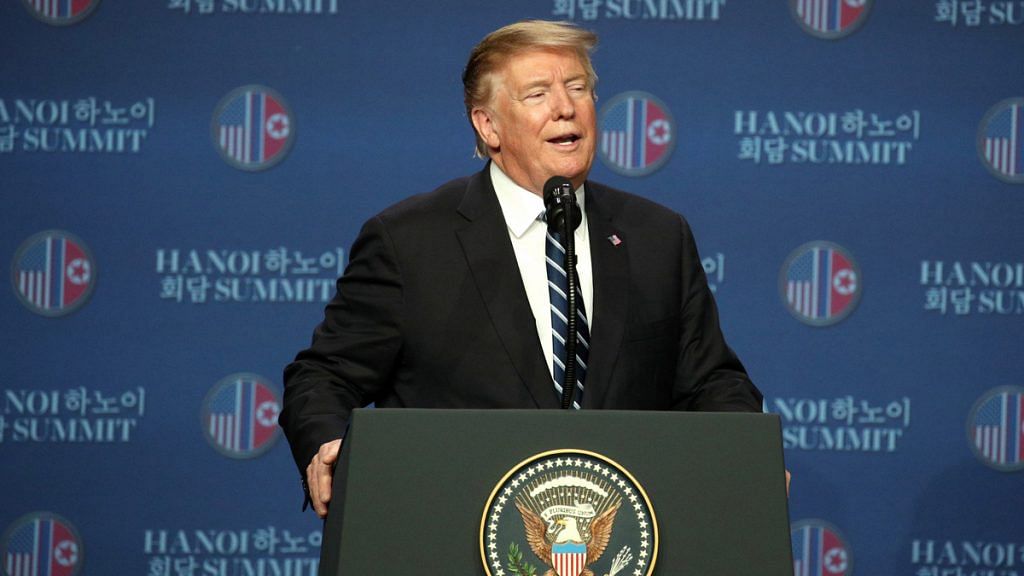Since the India-Pakistan crisis broke out earlier this month, US President Donald Trump has tweeted about his meeting with Kim Jong Un, his former lawyer Michael Cohen, Democrat Dick Blumenthal, jobs in Michigan, and Democrats and abortion.
But there is not a single tweet on the India-Pakistan security crisis, which is on the brink of escalation. Never mind that this escalation cycle could end with a possible nuclear warfare.
On Thursday, Trump finally broke his silence in Hanoi after his summit with Kim, but had only this to say: “We have I think… reasonably attractive news from Pakistan and India. They have been going at it. And we have been involved in trying to have them stop, and we have some reasonably decent moves.”
There was no clarity on what the “attractive news” constituted.
About twenty years ago, in a similar scenario during the Kargil conflict, the then US President Bill Clinton, however, had intervened in a dramatically different fashion.
One is bound to ask what has changed since then?
As the two countries appear to be going up the escalatory ladder, ThePrint takes a look at the current India-Pakistan crisis to understand how the world order and US’s role in it has radically shifted in the past two decades.
The Sharif-Clinton episode
To better understand the shift in US foreign policy, one must begin by looking at the role US traditionally used to play.
A quick look at the Sharif-Clinton meeting in Washington in 1999, whilst the Kargil conflict was being fought, would suffice.
During the conflict, Clinton phone called Pakistani Prime Minister Nawaz Sharif to stress that US saw Pakistan as the aggressor in the conflict and rejected the “fiction that [Pakistani] fighters were separatist guerrillas”.
A credible stick backed his rhetoric — he told Sharif that if Pakistani forces did not pull back, he would hold back a $100 million International Monetary Fund (IMF) loan that Pakistan desperately needed back then.
Sharif did not oblige, but arrived in Washington uninvited.
The manner in which Clinton and his national security team dealt with Sharif reflected sharp diplomatic skills. The US was perfectly aware of Sharif’s position and his limitations.
Strobe Talbott, then Clinton’s deputy secretary of state, wrote in his book Engaging India, “Adding to the danger was evidence that Sharif neither knew everything his military high command was doing nor had complete control over it.”
As Sharif arrived in Washington, Clinton’s goal was simple: ensure a ceasefire between India and Pakistan but only on the condition that Pakistan withdraws its troops.
When Sharif refused to follow the American demands, Clinton played the classic good-cop-bad-cop tactic.
He first told Sharif that White House would make a statement to the press stating that Pakistan supports terrorism in Afghanistan, as well as in India through its backing of Kashmiri militants.
This threat took Sharif by complete surprise.
Then, Clinton followed it up with a more moderate deal. He proposed a joint statement that would incorporate some of the “Pakistani language”.
But the key sentence in the new statement would be, as US desired: “The prime minister has agreed to take concrete and immediate steps for the restoration of the Line of Control.”
Sharif took the deal.
Shift to times of Trump
The aforementioned incident highlights how the US administration intervened in a high-stakes Kashmir crisis, and helped reduce hostilities.
Contrast that with the fact that today as two nuclear powers, India and Pakistan are on the verge of entering an escalatory cycle, where the US President only has a muted and cryptic statement to make.
What has changed?
Reconfiguration of US interests
First and foremost, in the last two decades, two long-drawn wars, a deep economic recession, and a populist president has forced US’s very formulation of its national interests to change.
Traditionally, US defined its national interest in a much broader way. Thus, while a crisis in South Asia might have only marginal economic effects on US, the American administration would consider it important given its long-term strategic objectives.
The US has made a long-term implicit bet on India — in its quest to balance China.
Given that bet, a traditional US administration would consider India entering a full-scale war against Pakistan to be against its national interest, and prompt it to intervene diplomatically.
That’s no more the case under Trump’s presidency.
Now the US national interests are limited. And its use of diplomacy is either unilateral or at worse, transactional.
Hollowing of US diplomatic machinery
The second big shift under the Trump presidency has been the dramatic scaling down of America’s diplomatic establishment.
As Ronan Farrow shows in his book, “War on Peace”, US doesn’t more have statesmen-like diplomats anymore.
To make things worse, under the Trump presidency, hundreds of important positions in the US State Department remain vacant. In addition, its funding has been substantially reduced.
The US State Department still does not have a permanent assistant secretary of state for South Asia.
The fact remains that no superpower can dominate the world order without skilled and sizeable diplomatic corps.
The combined effect of the reconfiguration of US’s national interests and the scaling down of its diplomatic machinery is a new world order. In such a world, “each man for himself” is the prevailing logic.
